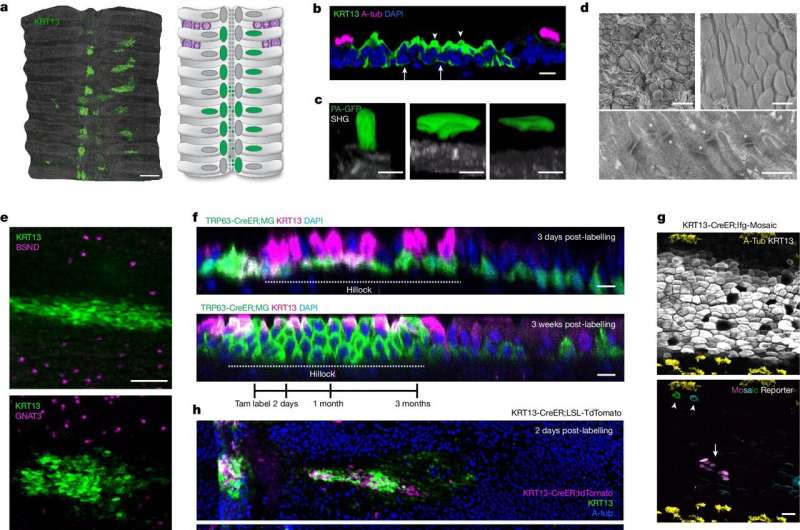This article has been reviewed according to Science X's editorial process and policies. Editors have highlighted the following attributes while ensuring the content's credibility:
fact-checked
peer-reviewed publication
trusted source
proofread
Study: Airway hillocks challenge our understanding of lung biology

Airway hillocks are mysterious, flat-topped structures that were only recently identified within regular lung tissue, and their role in airway biology and pathology has previously been unknown.
A research team from Tufts University School of Medicine and Massachusetts General Hospital is now reporting evidence that hillocks and their stem cells are physiologically distinct from other cells within the lung and consist of a stratified outer layer of scale-like squamous cells that protect an underlying layer of rapidly expanding basal stem cells that are capable of restoring airway tissue after injury.
The results are published in a study appearing May 1 in the journal Nature.
"This study links previous research describing seemingly disparate phenomena to an unappreciated reservoir of injury-resistant cells," says Brian Lin, GSB17, a research assistant professor of developmental, molecular and chemical biology at the School of Medicine, and a co-first, co-corresponding author on the paper.
"By doing a whole organ stain, structures popped out that aren't easily seen when looking at the tissue in slices."
Lin was among the group of scientists who, in 2019, first described the cells called hillocks, so named because of how they resemble mounds on the surface of lung tissue.
"The identification of hillocks explains a whole host of findings about airway regeneration," adds Jayaraj Rajagopal, MD, the senior author of the study and an investigator in the Center for Regenerative Medicine at Mass General. "It is remarkable to think these structures were missed for decades. They have implications for regenerative medicine and cancer alike."
In this new study, Lin and team generated a genetic mouse model that made it possible to fluorescently label hillocks and their progeny in the lungs.
They found that hillock-derived stem cells (the basal cells underlying the layers of scaly or squamous cells on top) could rapidly regenerate airway lining after injury and capable of creating all six component cell types of the pseudostratified airway epithelium.
The researchers also demonstrated that the stratified, tightly interlocking layers of squamous cells on the top of hillocks were resistant to a broad spectrum of insults, ranging from physical injury to acid injury to infection to toxins related to smoking.
Viral Shah, member of the Rajagopal Lab and one of the co-first authors, searched for hillocks in human airways by dissecting and staining human lung tissue and found that humans also have hillocks that mirror the structure and function of those in mice.
These findings establish that the presence of a stratified squamous epithelium, long thought to be a metaplastic (precancerous) response to damage is characteristic of an uninjured airway.
Dissections of hillocks revealed specific genes not expressed by other lung cell types which produce a hard protein in the keratin family similar to those used to form hair and nails.
Despite being so hardy, Lin says one of the study's most surprising findings is how quickly hillock cells replace themselves, hinting that part of their function is to be disposable. For example, in response to physical injury to the trachea, hillocks dramatically proliferate and migrate to spread stem cells to the impacted area in order to regenerate it.
Cells that divide so quickly are prone to mutation, and so a short life span for these cells is likely to prevent hillock cells from building up errors.
The research team plans to continue their characterization of hillocks, work that could alter our understanding of the progression of lung cancer, the physiology of conditions like asthma, and how the body combats viral infections and drug interactions. "I think we've cracked open the door, but there's so much more to do," Lin says.
More information: Brian Lin et al, Airway hillocks are injury-resistant reservoirs of unique plastic stem cells, Nature (2024). DOI: 10.1038/s41586-024-07377-1
Journal information: Nature
Provided by Tufts University





















